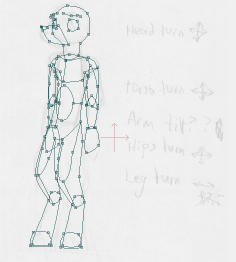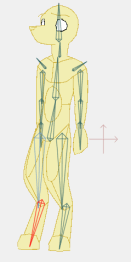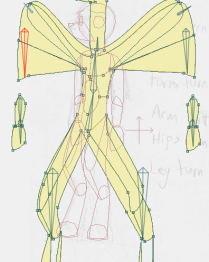Page 2 of 4
Posted: Tue Jul 17, 2007 2:58 am
by Kazerad
Patrick McClintock wrote:Kazerad,
If i may ask, where did you learn to make your 2-D meshes, they are outstanding.
Heh, thanks. This is the first model I've done this complicated and I used a lot of new methods, so it's hard to say. In doing this one, I tried applying concepts I learned from doing 3D modeling in Animation:Master. I based the line placement on muscles, and didn't turn anything to actual shapes until my wireframe was done.
Also, I tried to keep the number of points to a minimum - especially on flexible objects like arms and legs - so I could stretch them nicely.
Anyway, still working on a third version. I had to rebuild the shapes on his hips and thighs completely to allow for interpolated turns switching to side and back views.
Posted: Tue Jul 17, 2007 3:49 am
by heyvern
There it is again... that Animation:Master connection.
That would explain your understanding of bone constraints in AS!

That's what got me hooked on AS bones.
It seems that people who like Animation Master like Anime Studio. Is it the price? The software? The bones?
I always think of them both in the same glowing terms to be honest.

-vern
Posted: Tue Jul 17, 2007 10:05 pm
by Kazerad
heyvern wrote:That would explain your understanding of bone constraints in AS!

That's what got me hooked on AS bones.
I'd hardly call it "understanding". I had this model mostly planned out, then before making it I looked at that startup model in AS and thought "huh. I should try making his arms automatically move opposite ways".
Running into a bit of a problem now.. I misinterpreted the manual's description of switch layers as letting me key different bone and point positions within the switch, and I was hoping I'd be able to get an automatically interpolated switch between different bone and point positioning. However, it turns out that switches can just change point movement.
Is there a method or script that lets me switch bone positioning (with interpolation), or should I just make a different model and try to get the two as similar looking as possible before switching?
Posted: Tue Jul 17, 2007 10:57 pm
by Genete
Is there a method or script that lets me switch bone positioning (with interpolation), or should I just make a different model and try to get the two as similar looking as possible before switching?
Just do it! Morph your skeleton and record that morph into an action. That's the way to convert an skeleton into another without any script. I recommend to store in a one frame action, like Darthfurby explains it his wonderful video tutorials.
Regarding to the use of different skeletons with different vector layers corresponding to different body positions you can do two things:
1) Each vector layer in a switch layer have its own skeleton (the skeleton don't morph. Let's say you can move morphed copies of translated skeletons and each one bind a different vector layer of the switch layer. Then when you switch between one layer and other they are moving like if one single model it were. TO achieve this you can use one of the skeleton as a master and using constrains make all the clone morphed skeletons to move the same way.
2) Use a single skeleton that morphs through the time. Then the switch layers would be adapted to the new morphed skeleton moving its points adequately to the new achieved skeleton. Than movement would be done by hand and not using the switch interpolation method. To do this I recommend work only with one layer in the swtich layer. When you fininsh the animation then duplicate the vector layer and change the order of the shapes. Later using switch keyframes change from one vector layer to other to show the shapes in the proper order.
The solution number one can also have shapes at different order to allow make body turns.
Hope my explanations make sense.
-G
EDITED:
Here is a rough example of morph bones and use switch only for shape order and duplicate skeletons and bind each layer to each skeleton. In the last case you should enable "interpolate swicth layers".
The multiple skeletons is more elaborated and more complex. I think that morph bones is more easy.
http://www.darthfurby.com/genete/Other/ ... ample.anme
Posted: Wed Jul 18, 2007 3:25 am
by Kazerad
http://foxmage.com/NewerRig.anme
Made some improvements/simplifications. I tried applying a turning method with Actions (just 3/4 to side at the moment), but it seems a bit clunky how I have it set up (though that's probably just because I have very little experience with Actions and Switches).
I'll probably just make a few modifications of the model when I need a different angle, as I need them - unless I find some way to make the switches and actions method easier to work with.
Posted: Wed Jul 18, 2007 8:13 am
by funksmaname
Kazerad,
Really nice work here and i like the direction its going... I'm just a bit confused how you managed to make this nice looking character from what looks like 'roadkill' on frame 0... i dont think i could build a character like that without seeing exactly what i'm drawing...? or did you draw it first and then pull it appart? please explain

Posted: Wed Jul 18, 2007 9:21 am
by Genete
funksmaname wrote:Kazerad,
Really nice work here and i like the direction its going... I'm just a bit confused how you managed to make this nice looking character from what looks like 'roadkill' on frame 0... i dont think i could build a character like that without seeing exactly what i'm drawing...? or did you draw it first and then pull it appart? please explain

He uses the OffSet bone tool. But in his model, the binded points belong to several shapes at the same time, so the frame 0 explosion is also a distorsion.
There is a tutorial in the built in help that shows how to use Off Set bone tool.
-G
Posted: Wed Jul 18, 2007 8:01 pm
by Kazerad
funksmaname wrote:Kazerad,
Really nice work here and i like the direction its going... I'm just a bit confused how you managed to make this nice looking character from what looks like 'roadkill' on frame 0... i dont think i could build a character like that without seeing exactly what i'm drawing...? or did you draw it first and then pull it appart? please explain

Like Genete said, I used the Offset Bone tool. To answer your question, I drew it all at once then pulled it apart afterwards.
More specifically, I started by tracing an sketch I drew, then built the entire basic skeleton before worrying any about skinning. Then I pulled the skeleton apart (and back, via the Offset tool), then moved the shapes out to their bones. I put an onionskin a few frames ahead while I was moving the shapes, so all I had to do to get the shapes in the right place was have the onionskinning match my sketch in the background.
Using an onionskin marker makes it easy to stretch shapes across multiple, offset bones, since it gives you a real-time preview of how the character will look.



Posted: Wed Jul 18, 2007 10:22 pm
by heyvern
Yeeehaaa!
That's just how I work as well!
It's fun to see someone else with weird looking characters that have stretched out disconnected and misshapen limbs.

I render out the "assembled" character before offsetting to use as a reference.
-vern
Posted: Thu Jul 19, 2007 8:49 am
by funksmaname
ive used offset bones a lot of times, but only on totally seperate limbs - thats why it looks odd to me when the character has been steamrollered across the canvas

- i guess i need to experiment with roadkill and see if that improved joint connection (?)
Posted: Sun Aug 05, 2007 6:09 am
by Kazerad
Likewise, Vern, it's nice to see there's some pros using the same methods I do

heyvern wrote:I render out the "assembled" character before offsetting to use as a reference.
I usually just take a screenshot. I like to be able to see where the bones are too when I'm taking characters apart and putting them back together.
Anyway, version 3. This one's simpler; I removed some bones that weren't necessary and got rid of a lot of details; it should be fairly easy to do a 90 degree turn by only moving a few bones and points, though I haven't tried it yet. From there, it could be continued another 90 by reverse ordering the shapes in a switch, then the final 180 by doing the same thing with a mirrored layer.
I also simplified the arms and hands. His arms now use those "cross joints" I invented for his legs, since it feels more natural for me to position hands before I position elbows. Rather than detailing every finger, I based the hands off those of minor characters in Half Life 2, grouping all the fingers except the index and thumb together and making it easy to tweak with point and bone movement.
Also, I changed a lot of the bones that only affected one point to affect an area. This makes rotations sloppier without manually modifying points, but will make it easier to add clothing or accessories to the template later.
Download at
http://foxmage.com/waving.anme
Here he is enthusiastically saying hi. I made him translucent so I could see how shapes behind him looked without having to switch to the point layer, and put his colors into a style so I can quickly change them later.

Any comments, criticisms, etc. appreciated. Also, I accidentally built it on a skeleton layer rather than a switch; is there a way I can change the skeleton layer to a switch layer?
Posted: Sun Aug 05, 2007 9:01 am
by Genete
is there a way I can change the skeleton layer to a switch layer?
Solution
here.
Continue with this good work. It would produce a great technique.
Cheers!
-G
Posted: Sun Aug 05, 2007 6:24 pm
by Kazerad
Ah! Fix worked perfectly, Genete. Thanks.
Posted: Sun Aug 05, 2007 9:11 pm
by Thatch
Interesting though obviously beyond my current abilities as I have no clue how you are moving the thing around. "Manipulate Bones" gives me very rudimentary control of the figure. Wish I knew more about these rigs.
Nice job
J
Posted: Mon Aug 06, 2007 10:55 am
by dlangdev
awesome.
way too advanced for me, too.
keep it up, i'm following this thread really close.
i'd like to learn the technique as well, since the tail movement looks very similar to hair animation.
with regards to hair animation, i've been spending the time studying them on an open source 3D engine named
irrlicht, still playing around with the code and will take them over here after learning how it is done in 3D.



